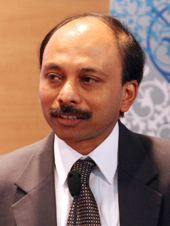The “Unstructured Information” Most Businesses Miss Out On
Businesses’ ability to process numbers in “well-behaved rows and columns” goes back 40 years, notes K. Ananth Krishnan, chief technology officer of Tata Consultancy Services, one of the largest companies in India. Figuring out how to mine and process the information in text, video, and audio is the new frontier.

K. Ananth Krishnan, chief technology officer of Tata Consultancy Services
Where do companies get their information? Information about competitors, about how customers think they’re doing, about whether a new product or service makes strategic sense?
Increasingly, data is coming at businesses in unstructured ways, says K. Ananth Krishnan, chief technology officer of Tata Consultancy Services. It’s coming from outside of companies, in the kinds of networking and SMS messaging habits that customers have. And it’s coming from unstructured sources inside companies, from in-house blogs to internal knowledge markets. That’s in addition to the structured data that companies are used to generating.
The challenge, Krishnan says, is to figure out how to process all of that unstructured text and video and audio and phone use that’s floating around outside of traditional databases. And then to figure out how to act on it.
Tata is in a unique position to think about this issue. It’s a large company, with over 198,500 IT consultants in 42 countries. It generated revenues of $8.2 billion in the fiscal year that just ended. The company was listed in Forbes’ sixth annual “Asia’s Fabulous 50 companies” and was named “Most Admired IT Company of the Year” by Bloomberg UTV in 2010.
Krishnan is in a unique position to think about this issue, too. He has been with TCS his entire career, since 1988. He has an M. Tech. in Computer Science and an M.Sc in Physics from the Indian Institute of Technology, Delhi.
Krishnan spoke with MIT Sloan Management Review editor-in-chief Michael S. Hopkins about how companies should be supplementing their structured data, when privacy concerns weigh in on information capture, and what computer programs can learn from the average five-year-old.
You’re based in India, and TCS is one of the major IT companies in Asia. From your perspective, how has the capture and use of information changed over the past couple of years? What are the trends?
I see two things changing. The first is the realization that there is more information outside of the structured rows and columns of databases that enterprises have traditionally looked to as their primary sources of information. The rise of unstructured information, of that part of the puzzle, is really huge in the last couple of years.

Comments (4)
Dr. Seshu Madabhushi
Siswanto Gatot
Sam Genesis
RG